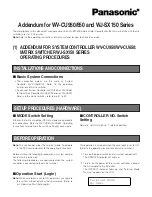
5. Multicast > Overview
109
Tsi578 User Manual
June 6, 2016
Integrated Device Technology
www.idt.com
Description of events in the figure:
1.
Port 1 receives a packet and consults its multicast group table. It determines that the packet is a
multicast packet by examining the packet’s destination ID and TT fields. The packet ackID field is
overwritten with the ingress port identifier.
— A packet request is issued by Port 1 to the switch fabric requesting packet transmission to the
ISF (MCE port).
— The multicast packet is placed in the port’s ingress buffer. Multicast packets residing in the
ingress buffer are subject to TEA as described in
. Multicast
packets residing in the ingress buffer are also subject to packet reordering.
2.
The packet request competes for access to the Multicast Engine (MCE) and is granted transmission
permission by the MCE specific arbiter.
3.
Having won arbitration to the MCE, Port 1 sends the multicast packet through ISF to the MCE.
The transfer occurs at 10 Gb/s
1
and starts after the first 8 or 16 bytes of the multicast packet has
been received in the ingress buffer (cut-through mode).
4.
The multicast packet is buffered by the MCE in the multicast work queue. The multicast group is
determined from the destinationID and TT fields of the packet and the vector computed for the
multicast work queue. Multicast packets residing in the multicast work queue are not subject to
reordering and are strictly processed in a FIFO manner. The multicast work queue operates in
cut-through mode.
5.
By consulting the multicast group table, Ports 0, 1, 2, and 15 are identified as members of the
vector and as the receiving ports.
— Because Port 1 is the ingress port which originates the multicast packet, as shown in the
ackID, it is removed from the Multicast Mask. The resulting Multicast Vector indicates that
the packet should be transmitted to Ports 0, 2, and 5.
6.
The MCE transmits the multicast vector to the ISF. The ISF is responsible for broadcasting the
packets to the broadcast buffers according to the multicast vector. The replication of the multicast
packets can occur at a rate of up to 30 Gbps in 4x mode or 37.5 Gbps in 1x mode. Transmission of
the packet copies to the selected Broadcast Buffers is a concurrent and parallel operation.
7.
The individual broadcast buffers must fully buffer the packet copies before presenting the
corresponding packet request to the destination arbiter (store and forward mode). Packet copies
residing in the broadcast buffers are subject to multicast latency timeout as described in
Maximum Latency Timer” on page 119
. However, they are not subject to packet reordering and are
processed in a strict FIFO manner.
8.
When the individual broadcast buffer is granted arbitration, the replicated multicast packet is
transmitted to the egress buffer at a rate of up to 10 Gbps. Although represented by the same
multicast vector, each individual broadcast buffer operates independently.
1. When the ISF clock speed is set to 156.25 MHz.
If a destinationID in the multicast group table is disassociated while the packet with that
destinationID is still in multicast work queue, the packet is silently dropped.
















































